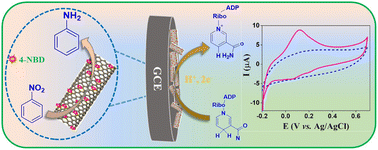Electrochemical sensing of NADH using 4-nitrobenzenediazonium tetrafluoroborate salt functionalized multiwalled carbon nanotubes
Abstract
In this work, multiwalled carbon nanotubes (MWCNTs) are functionalized using 4-nitrobenzenediazonium (NBD) salt, which is identified as an effective electrocatalyst for the detection of β-nicotinamide adenine dinucleotide (NADH). The NBD functionalized MWCNT (NBD-MWCNT(w) (w-washed)) was characterized using various physicochemical characterization methods. Cyclic voltammetric measurements showed that NBD-MWCNT(w) modified glassy carbon electrode (NBD-MWCNT(w)/GCE) was able to produce the anodic wave for oxidizing NADH at the applied overpotential of 0.12 V, which is 0.67 V cathodic when compared to that of bare GCE. Besides, the sensitivity of the electrode also doubled. The sensitivity and limit of detection (LoD) were 8.5 × 10−4 A M−1 and 3.75 μM, respectively. The linear range of the sensor was 5 to 60 μM. The selectivity studies further proved that the matrix is specific towards detecting NADH in the presence of other possible interfering molecules. The diffusion co-efficient and apparent rate constant of NADH obtained were 3.8 × 10−6 cm2 s−1 and 1.12 × 107 mol−1 cm3 s−1 respectively. Additionally, the electrode is employed to detect the analyte in real samples.



 Please wait while we load your content...
Please wait while we load your content...